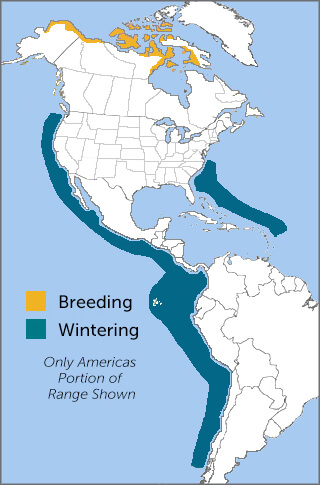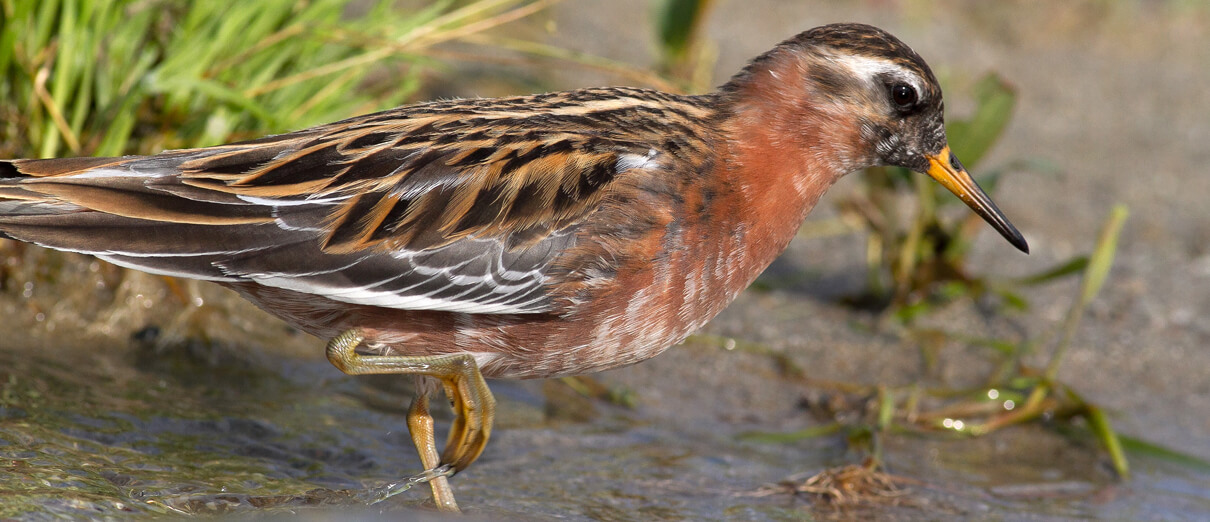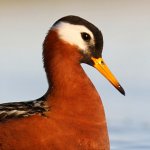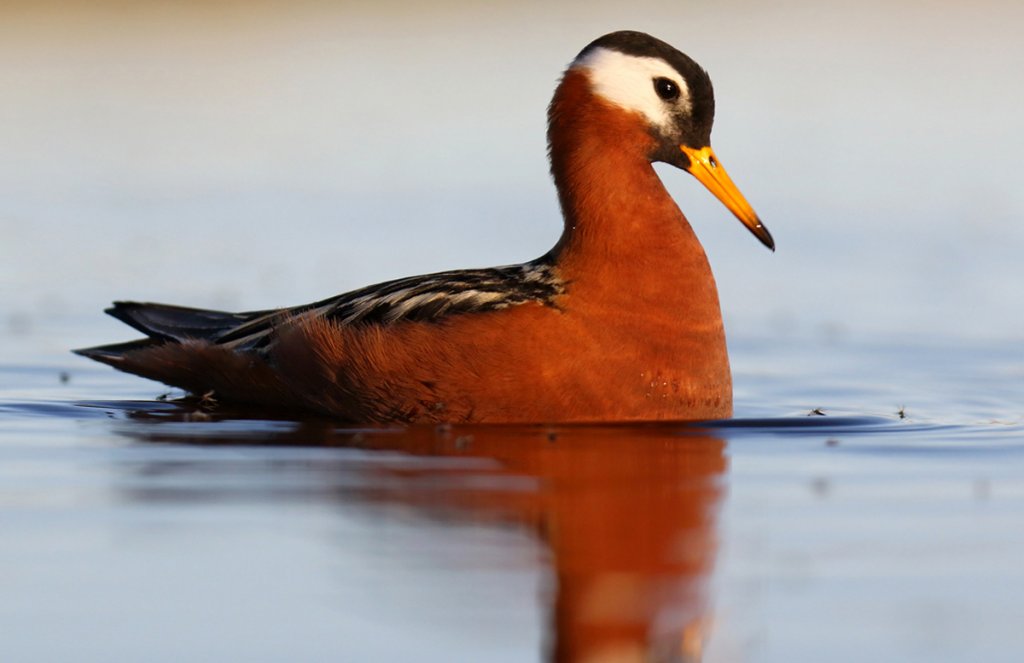
The Red Phalarope, like the American Woodcock and Long-billed Curlew, is a most unusual shorebird. Its genus name Phalaropus derives from the Ancient Greek words phalaris, "coot," and pous, "foot." The species name fulicarius also means "coot," but derives from Latin.
Phalaropes, like coots, have lobed toes, which help these birds swim efficiently. The Red Phalarope is not only a good swimmer but a tough bird overall, having to navigate two worlds: the tundra and the high seas. It is larger and more pelagic (ocean-going) than the world's two other phalaropes, the Wilson's and the Red-necked.
The most unusual aspect of phalarope lives can be observed during the nesting season, with males and females swapping customary roles.
Role Reversal
Red Phalaropes and their kin employ a rare mating arrangement known as polyandry, which occurs in less than one percent of all bird species. In a polyandrous system, most commonly seen among shorebirds, customary gender roles are reversed: During the nesting season, a female phalarope claims territory, initiates courtship, then mates with multiple males, while each male takes on the traditionally female duties of incubating eggs and raising young.
This role reversal even extends to the birds' appearance. Female phalaropes are larger and, during breeding season, more brightly colored than males. Outside of nesting season, Red Phalaropes appear alike in their gray-and-white winter plumage. This coloration likely gave rise to the species' Eurasian common name, the "Grey Phalarope."
Out at Sea
The Red Phalarope breeds far from most human activity in Arctic regions of North America and Eurasia. These remote breeding areas are usually close to the coast on flat, boggy tundra. Post-nesting, the Red Phalarope follows oceanic migratory routes to spend winters far out at sea, floating on the ocean surface and swimming like a duck. Outside of their breeding season, Red Phalaropes are rarely seen near land, although rare vagrants sometimes turn up in unusual sites after severe storms.
Although generally silent while at sea, Red Phalaropes are quite vocal on their breeding grounds, where they keep in contact with a variety of twittering calls.
Listen here:
(Audio: Patrik Åberg, XC406388. Accessible at www.xeno-canto.org/406388)
Ladies' Choice
Once on the breeding grounds, a female Red Phalarope will take the lead in establishing and defending a nest territory. If not already paired up, she courts males through circling flight displays or by swimming after them. Both members of a pair search for a suitable nest site, usually a simple scrape on the ground near water. After the female lays her clutch of two to four eggs, she leaves the male to incubate and moves on to find a second mate and lay a second clutch.

Meanwhile, the male lines the nest scrape with vegetation and begins to incubate. After 18 to 20 days, the eggs hatch, and the male leads his offspring to the closest water. Although young Red Phalaropes are capable of feeding themselves, the male sometimes stays with them until they can fly — for about two weeks more.
Spinning for Its Supper
Phalaropes have a distinctive feeding style usually seen on the breeding grounds: They turn in small, rapid circles in shallow water (up to 57 revolutions per minute!), creating whirlpools that pull insects and other food items within reach of the birds' long bills. A group of phalaropes feeding in this way is a dizzying sight!

Help support ABC's conservation mission!
The Red Phalarope changes its feeding style during the winter. It has particularly dense plumage for extra buoyancy while at sea and feeds on or just below the water's surface. On the open ocean, the birds gather near ocean upwellings, which bring food such as plankton and small fish to the surface. (Many other seabirds, including the Peruvian Diving-Petrel, Waved Albatross, and Inca Tern take advantage of upwellings for the same reason.) The Red Phalarope often associates with groups of whales, which also seek out upwellings. In fact, European sailors nicknamed this species the “bowhead bird” because it was often seen around pods of Bowhead Whales.
Rough Seas Ahead?
The Red Phalarope is threatened by climate change, which is leading to habitat loss on the breeding grounds and affecting food availability at sea. Increased human development in the Red Phalarope's breeding range seems to discourage nesting birds and could also lead to collisions with powerlines.
During its time at sea, the Red Phalarope is also vulnerable to oil spills and plastic trash. Like the Laysan Albatross and Tufted Puffin, these birds may mistake small bits of plastic for food, which can lead to starvation.
ABC supports legislation that would dramatically reduce the amount of plastic that is discarded and washes into our oceans. You can learn more about the global plastic pollution crisis and its effects on birds by watching a recent ABC webinar, entitled “Let's Talk Trash: Plastic Pollution, Birds, and Our Oceans.”
Donate to support ABC's conservation mission!



















































